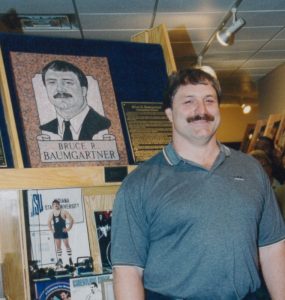
Sports Illustrated Vault: Bruce Baumgartner
Originally Published in October 20, 1986 issue of Sports Illustrated
By Barry McDermott
Deep in the athletic center of Edinboro University, in Edinboro, Pennsylvania, Bruce Baumgartner, a Distinguished Member inducted into the National Wrestling Hall of Fame in 2002, is putting in more hard time. At the end of a subterranean hallway embroidered haphazardly with red dots—speckles of blood—Baumgartner is tucked away in his private cell. He has been working in the wrestling room for a solid hour, 60 minutes of continual skirmishing against alternating opponents. Consequently, Baumgartner looks more the survivor than the Hidden Legend. His hair is slick, and his shirt and shorts are darkened with sweat. He kneels on the mat, his chest heaving. A red welt runs down a cheek, and over one eye there is a dribble of blood.
He rises, walks over to a corner and climbs onto a leg-exercise machine. "Tighten it," he says.
Dean Hall, another wrestler, turns a handle, then glances at a watch. "Go!" he says. Baumgartner's legs begin pushing like pistons. The machine's steel parts clatter. Just five seconds into the exercise, Baumgartner's movements start to slow. "Go, go, go!" screams Hall. "Got to win. Don't let it beat you."
 Now Baumgartner's head is thrashing about. His shoulders are rocking, trying to force the strength from his upper body down to his legs. Grunting, eyes closed, he bites on a wad of his T-shirt. The din from the machine, from Hall, from Baumgartner, overwhelms the room.
Now Baumgartner's head is thrashing about. His shoulders are rocking, trying to force the strength from his upper body down to his legs. Grunting, eyes closed, he bites on a wad of his T-shirt. The din from the machine, from Hall, from Baumgartner, overwhelms the room.
Half a minute later, Hall shouts, "That's it!" Baumgartner slumps over the handlebars. "Twenty seconds," says Hall. "Get ready. Ten seconds, nine, eight...." Baumgartner has four more sets to do.
And he will do them. He must. Baumgartner is the best superheavyweight wrestler in the world. His championships include the NCAA, Olympic Games, World University Games, Goodwill Games and three World Cups. But never has he won the world championship. This week in Budapest he will wrestle once again for the only major title that has eluded him.
By Barry McDermott
Deep in the athletic center of Edinboro University, in Edinboro, Pennsylvania, Bruce Baumgartner, a Distinguished Member inducted into the National Wrestling Hall of Fame in 2002, is putting in more hard time. At the end of a subterranean hallway embroidered haphazardly with red dots—speckles of blood—Baumgartner is tucked away in his private cell. He has been working in the wrestling room for a solid hour, 60 minutes of continual skirmishing against alternating opponents. Consequently, Baumgartner looks more the survivor than the Hidden Legend. His hair is slick, and his shirt and shorts are darkened with sweat. He kneels on the mat, his chest heaving. A red welt runs down a cheek, and over one eye there is a dribble of blood.
He rises, walks over to a corner and climbs onto a leg-exercise machine. "Tighten it," he says.
Dean Hall, another wrestler, turns a handle, then glances at a watch. "Go!" he says. Baumgartner's legs begin pushing like pistons. The machine's steel parts clatter. Just five seconds into the exercise, Baumgartner's movements start to slow. "Go, go, go!" screams Hall. "Got to win. Don't let it beat you."
 Now Baumgartner's head is thrashing about. His shoulders are rocking, trying to force the strength from his upper body down to his legs. Grunting, eyes closed, he bites on a wad of his T-shirt. The din from the machine, from Hall, from Baumgartner, overwhelms the room.
Now Baumgartner's head is thrashing about. His shoulders are rocking, trying to force the strength from his upper body down to his legs. Grunting, eyes closed, he bites on a wad of his T-shirt. The din from the machine, from Hall, from Baumgartner, overwhelms the room.Half a minute later, Hall shouts, "That's it!" Baumgartner slumps over the handlebars. "Twenty seconds," says Hall. "Get ready. Ten seconds, nine, eight...." Baumgartner has four more sets to do.
And he will do them. He must. Baumgartner is the best superheavyweight wrestler in the world. His championships include the NCAA, Olympic Games, World University Games, Goodwill Games and three World Cups. But never has he won the world championship. This week in Budapest he will wrestle once again for the only major title that has eluded him.